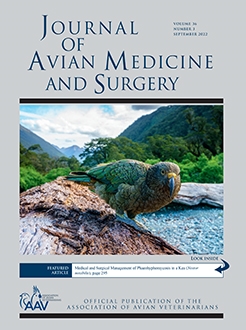A 20-year-old, female, red-lored Amazon parrot (Amazona autumnalis) was presented for a 2-week history of weakness. On physical examination, the bird was quiet, fluffed, weak, and had a distended coelom. Radiographic and ultrasound imaging revealed coelomic distention, increased pulmonary parenchymal opacity, renomegaly, dilated intestines, and a thickened ventricular wall. The results of a complete blood cell count indicated the patient was anemic (28%) and had intermediate to large lymphocytes with immature chromatin that were suspected to be neoplastic. Immunocytochemistry on peripheral blood determined that the suspected circulating neoplastic cells were cluster of differentiation (CD) 3+ and occasionally expressed multiple myeloma oncogene 1 (MUM1). Abnormalities from a plasma biochemistry panel were moderate hyperphosphatemia (6.8 mg/dL), marked hyperproteinemia (13.6 g/L), analbuminemia (0 g/dL), and marked hyperglobulinemia (13.6 g/dL). Agarose gel plasma protein electrophoresis documented the presence of albumin (1.2 g/dL) and monoclonal bands which, on reduced lithium dodecyl sulfate polyacrylamide gel electrophoresis, resolved as 60-kd and ∼25-kd bands consistent with immunoglobulin Y heavy and light chains. On the basis of these findings, multiple myeloma was diagnosed. Because of a poor prognosis, the bird was euthanized for postmortem examination. Bone marrow cytology from samples collected during the postmortem examination revealed 17.4% plasma cells and 24% large immature cells with occasional plasmacytoid features. Histopathologic findings included aggregates of neoplastic plasma cells in the bone marrow, spleen, kidney, liver, gastrointestinal tract, muscle, ovary, and brain. The neoplastic cells were strongly immunoreactive for MUM1 and cluster of differentiation 3 (CD3), but negative for CD79a, paired box protein 5, and CD20. This confirmed the clinical diagnosis of multiple myeloma. This report describes an avian immunoglobulin Y-secreting multiple myeloma with aberrant CD3 expression and pseudoanalbuminemia. Aberrant CD3 expression by avian multiple myeloma may explain previously published cases of birds with a monoclonal gammopathy and apparent T-cell lymphoma diagnosed by CD3 immunoreactivity.
How to translate text using browser tools
25 November 2022
Multiple Myeloma with Aberrant CD3 Expression in a Red-Lored Amazon Parrot (Amazona autumnalis)
Gretel Tovar-Lopez,
Samantha Evans,
Juan F. Muñoz Gutiérrez,
A. Russell Moore,
Miranda J. Sadar
ACCESS THE FULL ARTICLE
Amazon parrot
Amazona autumnalis
analbuminemia
Avian
Hypergammaglobulinemia
immunohistochemistry
psittacine





